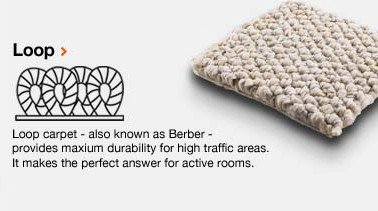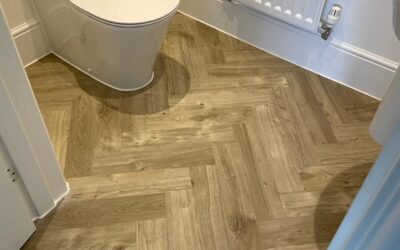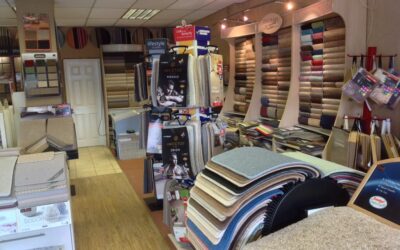- By Michelle Holman
- 06 Dec, 2018
Don’t know your woven from your tufted, your Polyamide from your Polypropylene? Fear not! With our carpet guide, you won’t need to tread carefully around our showrooms

GETTING STARTED
When you’re planning to change/lay a new carpet, think about what sort of footfall it will have to endure, this will help narrow down your options. You can afford to treat yourself to a bit of luxury in the bedroom, where a softer pile will withstand slippers or bare feet, but you’ll need something with a dense, tight, low-pile tuft in those high-traffic areas.
The density of your carpet should be a key consideration, particularly if you are looking to lay it in a high-traffic area, such as a hallway or stairs. The density is determined by how closely knitted each fibre is to another, rather than the depth of the carpet.
At Phoenix Flooring Limited, Bristol we are happy for you to take some samples home, before making a final decision, and we also offer a FREE OF CHARGE and NO OBLIGATION measuring and quotation service.
Place the sample in lighter and darker areas of the room you’re planning to carpet to get an idea of how the colour will be affected by light. Tread on it as well, to see how easily and quickly it springs back into shape.
THE CARPET OPTIONS
PILE FIBRE
Wool – Generally used for high-quality carpets, you’ll pay more for natural materials, but you’ll get a great looking floor covering that is made from sustainable fibre, is resilient and highly durable. It gets top marks for insulation, too – good for reducing heat loss and noise – and retains its appearance remarkably well. Wool also feels beautiful and soft underfoot!
Wool-mix – Some consider a mix of 80% wool, 20% man-made fibres (such as polyamide or polyester), as the best combination for an all-purpose carpet.
Polypropylene – This man-made carpet fibre is a popular choice, because it’s hardwearing and resistant to stains. It can be cleaned using a part-bleached cleaning solution, although always check with the manufacturer or retailer first. However, Polypropylene is flammable and not self-extinguishing.
Polyamide (also known as nylon) – Available in a wider range of hues and vibrant clear colours that can’t be reproduced in wool. A good all-rounder for family homes, good-quality polyamide or nylon carpets come with built-in stain-resistant treatments and score high marks for wearability.
Polyester – Often used for textured or shag carpets. Polyester is most like wool in appearance and feel, and is remarkably soft, durable and stain resistant. Most often used as a blend, rather than on its own.
PILE TYPES
Woven or tufted?
There are two types of carpet most commonly sold in the UK: tufted and woven carpets.
Woven carpets, such as Axminsters and Wiltons, are made using traditional loomed methods, and are labour intensive. You’ll get a premium finish, but these carpets, widely regarded as the top-end choice, also come at a premium price.
Tufted is the most popular carpet type today and is made by a row of needles punching the pile yarn into a base material. It’s easier to manufacture and can be made using all types of yarns with a variety of finishes. Tufted carpet can be looped or cut (or both).
Woven
Axminster – Made a bit like an oriental rug, with fibres woven in and out through the surface backing on an Axminster machine. Axminster carpets are known for their rather grand, intricately patterned designs, quality and durability – and they are expensive. Until recently, most Axminster’s came in a velvet finish, but now manufacturers are using twisted yarn as well, to reduce shading.
Wilton – Another luxury, quality carpet, it derives its name from the type of loom used, which weaves the yarn in a continuous strand. Available in a wide range of patterns, Wilton carpets have a smooth, velvety, woven surface.
Tufted
Twist – Hardwearing carpets with yarn which has been twisted tightly together, creating a one-way pile direction. Twist carpets are the most popular type of carpet currently being produced and come in plain colour or in a combination of complimentary shades to create a ‘heather’ look, which helps hide build-up of dust or animal hairs. It’s also a good choice for places where tread always wears, such as hallways and stairs.
Berber or looped pile – Originally named after carpets made by the Berber tribe in Africa, a Berber or looped pile carpet is made from uncut continuous loops on the surface and has a distinctive knot appearance. Carpet can be looped, with a low-profile pile construction, which is known for maintaining its appearance, or have loops of different heights to form a textured pile. For a busy room, choose a Berber with smaller or tighter loops, which easily bounce back and decrease the chance of loops crushing and matting with wear and tear. A good all-rounder, however, not a great choice if you have pets, particularly cats, as they may pull up the loops with their claws.
Flatweave – A good choice for stair runners, flatweave is created by interlocking warp (vertical) and weft (horizontal) threads. Although it’s looped, it gives the impression of being completely flat and feels firm underfoot.
Saxony – A deep-pile carpet that is popular for bedrooms, it has a cut pile with long tufts giving it a gentle, soft feeling underfoot and a luxurious look. Its long pile makes it easy to flatten, however, so wardrobe and cupboard feet marks won’t necessarily spring back as you might wish.
Shag – An opulent, luxurious deep shagpile. It has extra long tufts to give it its super shaggy look. Not ideal for areas with high-traffic, but a fantastic choice for a warm, gentle way to wake-up when you first step out of bed in the morning!
THINGS TO CONSIDER
UNDERLAY
As well as working as a shock absorber, adding cushioning and comfort underfoot, a good underlay helps keep in heat and could help reduce your energy bills. Invest in a good underlay, if you can, whatever the budget for your carpet. A heavy-duty one will extend the life of your carpet. Underlay helps a new carpet to sit properly and wear evenly. It reduces pile compression and enables a carpet to keep its appearance for longer.
MAINTENANCE
New carpets tend to shed fluff. It won’t harm a new carpet to vacuum it as soon as it has been laid, which will take up any short loose fibres. Vacuum at least once a week and use a barrier mat in areas that are most likely to soil, such as by the front door.


Why not pop in to our Stoke Lodge, Bristol, Carpet and Flooring Showroom and view our extensive range of Karndean, Amtico, Laminates, LVT, vinyl, coir matting, carpet and flooring.
We provide a FREE – NO OBLIGATION QUOTE on all jobs, no matter how big or small, residential or commercial.
Our team will happily visit your home or premises and bring samples with them.
Please visit our Showroom at :
Phoenix Flooring Limited
5 Chelford Grove
Stoke Lodge
Bristol
BS34 6DD
01454 620707
https://www.phoenixflooring.org/
enquiries@phoenixflooring.org





